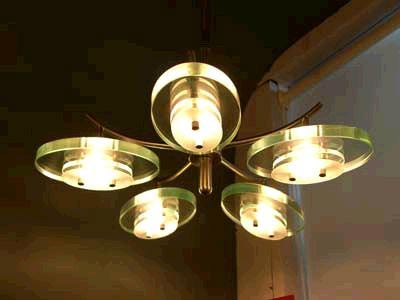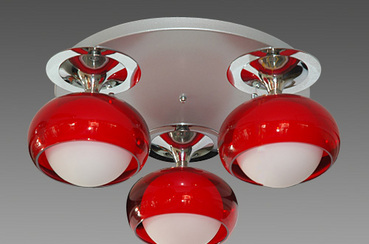Ceiling lamps are currently the most used lamps in home decoration. Its style is simple and generous, with good brightness and easy cleaning. Therefore, households seeking simplicity and practicality generally use ceiling lamps. The average family will use a ceiling lamp as the main light in each bedroom, and then use one in the toilet and kitchen. As a result, the usage rate of ceiling lamps is relatively high. Although the ceiling lamp is good, if you don’t know how to buy, you will probably buy a bad product. It needs to be replaced after use, or it may bring bad effects to the whole room.
How to Judge the Quality of a Ceiling Light
First of all, everyone must understand that a lamp (no matter what lamp) is composed of three parts: the lamp body, the light source and the electrical appliances. The most important one is the light source, because it is the part that can really bring the lighting effect to everyone. The lamp body is generally used for decoration and auxiliary light source. Electrical appliances are for the stable light emission of the light source, or to give the light source an instantaneous start voltage, etc. Therefore, for lamps, the light source is the most important.
First Step: Detect the Light Source
The judgment of the light source should start from the following points:
- Luminous flux: As the name suggests, it is how much the light source emits.
- Color temperature: the temperature of the color of the light source, which is commonly referred to as “warm white light”, “white light” or “cold white light”. In fact, it is not called that in the industry. It is usually expressed by a numerical value. Warm white light is “below 3300k”, white light is “5300k and above”, and there is a middle color “3300k-5300k”.
- Color rendering: the degree of reaction of the light source to the true color of the object. We believe that sunlight and incandescent lamps have the best and most realistic response to the color of objects, so their color rendering is defined as 100. Generally, a color rendering index above 80 is a better light source, but it is difficult to achieve general ceiling lamps.
- Average life span: This is different from other things. Light sources are all talking about the average life, that is, a batch of light sources are lit at the same time, and the time when 50% of the light sources fail is the average life of this batch of light sources. Nowadays, the general ceiling lamps will be guaranteed for one year, in fact, their life span is much longer than one year. So everyone can use it with confidence.
- Light efficiency: This indicator is very important, which refers to how much light is emitted by different light sources at the same time and consumes the same amount of electricity. In other words, for the same bright light, the power consumed by him may be different. A light source with high luminous efficiency is definitely more power-efficient than a low-efficiency light source.
- Strobe: the number of times the light source flashes per second. Why does the fluorescent light in some homes feel like it is flashing? In fact, the electrical appliances are not good enough to provide him with a stable voltage. Light sources with large strobes are the most harmful to the eyes. Fluorescent light source flickers are more serious.

How to Judge the Quality of the above 6 Indicators?
Because most ceiling lights are white light, let’s talk about white light. Some families will find that some ceiling lamps look brighter while others are darker when choosing lamps? Why are some light colors whitish, some purple or blue? This is caused by different light effects and different color temperatures of the light sources. The light source produced by some manufacturers has low luminous efficiency, but in order to make the customer look brighter, the color temperature is increased. It looks brighter, but it’s not really bright. It’s just an illusion of the human eye. This damages the eyes greatly, and the eyes are easily fatigued. In this environment for a long time, eyesight will get worse and worse, so why is it that children are easily nearsighted. That’s because the light source of the desk is not good.
Judgment Method of Color Temperature
Lights with high color temperatures look bluish or purple. People in the industry know that the color temperature is wrong at first glance, but customers often don’t see it. Here is a method to teach you, that is, without other light sources, just light a lamp, and then stand under the lamp to read (if you choose a table lamp or an energy-saving lamp, read the book at a distance of 1m from the light source). If it looks clear and bright, it means that the light source is better and the luminous efficiency is high. If it is not clear, fuzzy, or not bright, it means that it is not really high in light efficiency, but just an illusion of the eyes.
It is easier to judge whether the color temperature of a light source is too high. Reach the palm of your hand to the light source and look at the color of your palm. If it is ruddy, it means that the color temperature is just right and the color rendering is good. If the palm of your hand is blue or purple, the color temperature is too high.
Step 2: Look at Electrical Appliances
Everyone should know that all fluorescent light sources need a ballast to be lit. The ballast can bring an instantaneous starting voltage and a stable voltage during operation to the light source. Fluorescent lamps without a ballast will not light up! The quality of the ballast directly determines the life and light efficiency of the lamp. Generally, the quality of the ballasts produced by more formal manufacturers is better.
Step 3: Look at the Lampshade
After seeing the inside of the lamp, let’s take a look at the problem of its mask. There are many manufacturers of ceiling lamps on the market now, and they use different mask materials. The most common ones are acrylic mask, plastic mask and glass mask. The best is an acrylic mask that has been stretched twice. Acrylic is a kind of plastic, it is soft, light, light transmittance, not easy to be dyed, and will not turn yellow due to chemical reaction with light and heat. Its light transmittance is the most concerned by customers.

Types of lampshades
Generally speaking, the light transmittance of plastic mask can reach up to 60%, while acrylic can reach more than 90%. In addition, the acrylic mask that has been stretched twice transmits light evenly, and the light source cannot be seen from the surface. The glass lampshade is even worse. If the installation is not firm, it will fall down and hit people. The price is also the highest for acrylic, generally 40w is above $18, good brand retail sells for about $22, and plastic is only about $9. Good brand manufacturers generally do not have such products. This kind of product is made by small manufacturers and the cost is very low. Many of them are made of leftover materials, which have poor heat resistance and are easy to turn yellow. Glass is even cheaper, and now such products can only be seen in poor building materials markets and counties.

How to judge the quality of the lampshade
First press the mask with your hands to see how soft it is, it’s soft. Then put your hands on it and look at the color, it’s rosy. Finally, open the cover to see if it is easy to disassemble. Because it is inevitable that it needs to be removed and scrubbed, sometimes mosquitoes enter and need to be cleaned. It is troublesome to buy one that is not easy to disassemble. Some large manufacturers now use the rotary disassembly, which can be removed with a slight twist. Very convenient. Good brand products are very user-friendly. There are also anti-mosquito mats, which make it difficult for mosquitoes to get in.
Open it to see if the buckles of the light source, electrical appliances, and wires are firm, and the wiring is neat, not messy, or entangled. However, if the above conditions are met, the prices are basically around $22 for 40w, $16 for 38w, $11 for 22w, and $5 for 10w.








